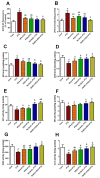Selenium Nanoparticles with Prodigiosin Rescue Hippocampal Damage Associated with Epileptic Seizures Induced by Pentylenetetrazole in Rats
- PMID: 35336729
- PMCID: PMC8945383
- DOI: 10.3390/biology11030354
Selenium Nanoparticles with Prodigiosin Rescue Hippocampal Damage Associated with Epileptic Seizures Induced by Pentylenetetrazole in Rats
Abstract
Background: Prodigiosin (PDG) is a red pigment synthesized by bacterial species with important pharmaceutical and biological activities. Here, we investigated the neuroprotective and anticonvulsant activities of green biosynthesized selenium formulations with PDG (SeNPs-PDG) versus pentylenetetrazole (PTZ)-induced epileptic seizures.
Methods: Rats were assigned into six experimental groups: control; PTZ (60 mg/kg, epileptic model); sodium valproate (200 mg/kg) + PTZ; PDG (300 mg/kg) + PTZ; sodium selenite (0.5 mg/kg) + PTZ; and SeNPs-PDG (0.5 mg/kg) + PTZ. The treatment duration is extended to 28 days.
Results: SeNPs-PDG pre-treatment delayed seizures onset and reduced duration upon PTZ injection. Additionally, SeNPs-PDG enhanced the antioxidant capacity of hippocampal tissue by activating the expression of nuclear factor erythroid 2-related factor 2 and innate antioxidants (glutathione and glutathione derivatives, in addition to superoxide dismutase and catalase) and decreasing the levels of pro-oxidants (lipoperoxidation products and nitric oxide). SeNPs-PDG administration inhibited inflammatory reactions associated with epileptic seizure development by suppressing the production and activity of glial fibrillary acidic protein and pro-inflammatory mediators, including interleukin-1 beta, tumor necrosis factor-alpha, cyclooxygenase-2, inducible nitric oxide synthase, and nuclear factor kappa B. Moreover, SeNPs-PDG protected against hippocampal cell loss following PTZ injection by decreasing the levels of cytosolic cytochrome c, Bax, and caspase-3 and enhancing the expression of anti-apoptotic Bcl-2. Interestingly, SeNPs-PDG restored the PTZ-induced imbalance between excitatory and inhibitory amino acids and improved monoaminergic and cholinergic transmission.
Conclusions: These promising antioxidative, anti-inflammatory, anti-apoptotic, and neuromodulatory activities indicate that SeNPs-PDG might serve as a naturally derived anticonvulsant agent.
Keywords: apoptosis; epilepsy; neuroinflammation; neurotransmission; oxidative stress; prodigiosin; selenium nanoparticles.
Conflict of interest statement
The authors declare no conflict of interest.
Figures






References
-
- Yuan X., Fu Z., Ji P., Guo L., Al-Ghamdy A.O., Alkandiri A., Habotta O.A., Moneim A.E.A., Kassab R.B. Selenium nanoparticles pre-treatment reverse behavioral, oxidative damage, neuronal loss and neurochemical alterations in pentylenetetrazole-induced epileptic seizures in mice. Int. J. Nanomed. 2020;15:6339. doi: 10.2147/IJN.S259134. - DOI - PMC - PubMed
LinkOut - more resources
Full Text Sources
Research Materials

